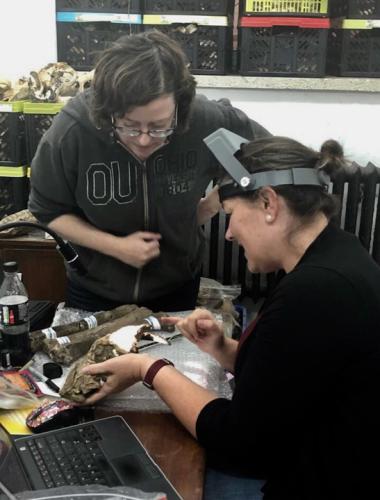
Curran digs into animal fossils in Romania in search of human migration answers

If early human ancestors (hominins) dispersing from Africa into Eurasia 2 million year ago (Ma) moved through southern Romania, they would have found monkeys on foot rather than in trees, short-necked giraffes, rhinos, and saber-toothed cats — quite different from the Europe of today.
During the early Pleistocene of Eurasia, these hominins also would have encountered significantly different environments from those that exist today, and probing the fossil record, particularly the fauna (animals), can help shed light on how hominins lived then and the implications for today.
Dr. Sabrina Curran is part of a research team digging further into the fossil record in one possible pathway for that migration, the Olteţ River Valley in southern Romania. Fossil hominins have been found in Georgia to the east of Romania dating to 1.8 Ma and Spain to the west at 1.4 Ma, so the team is searching for evidence of hominin presence in Romania.
Curran, assistant professor of Anthropology at Ohio University, is working to both identify the fossilized fauna (taxonomy) and place them in time chronologically. The site she is working at, Grăunceanu near Craiova, is well-known for its rich deposit of fossils originally discovered in the 1960s. Thousands of fossils were collected during that time, half of which are now stored at the “Emil Racoviţă” Institute of Speleology in Bucharest.
The international research team plans to return to Romania in 2021 to study the other half of the collection, currently stored in the Museum of Oltenia in Craiova.
Curran and the team are taking a two-pronged approach: investigating the fossils in storage and doing additional fieldwork.
So far, they have found:
- A diversity of animal species, including animals no longer in existence.
- Fossil remains of animals similar to modern-day moose, bison, deer, horse, ostrich, pig and many others.
- Some animals not previously identified in the area.
- A fossil species of pangolin, which were thought to have existed in Europe during the early Pleistocene but had not been solidly confirmed until now.
- Previously undocumented fossil deposits in the Olteţ River Valley.
Results of the work by project leaders Curran, Claire Terhune (University of Arkansas), Alexandru Petculecu (“Emil Racoviţă” Institute of Speleology), and their international team are published in the journal Quaternary International.
